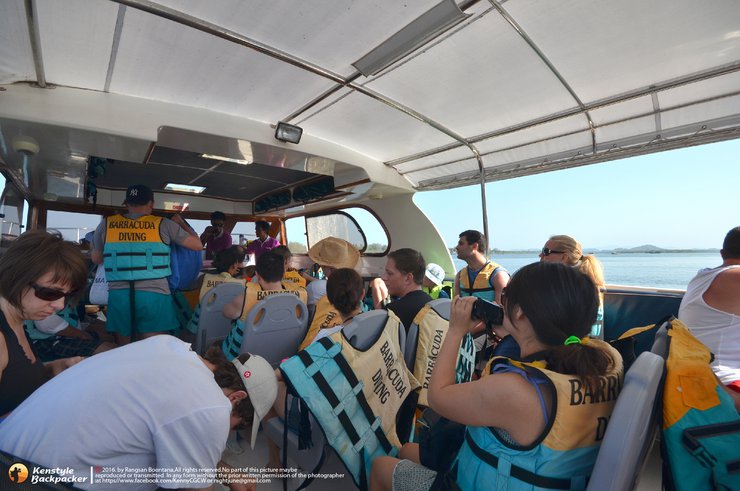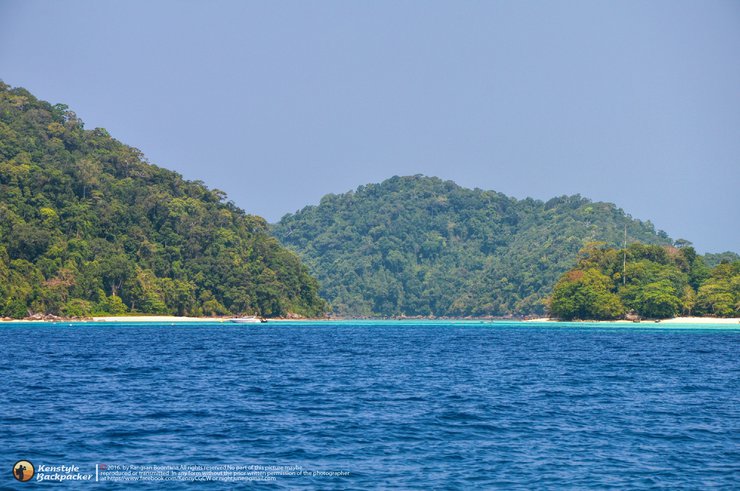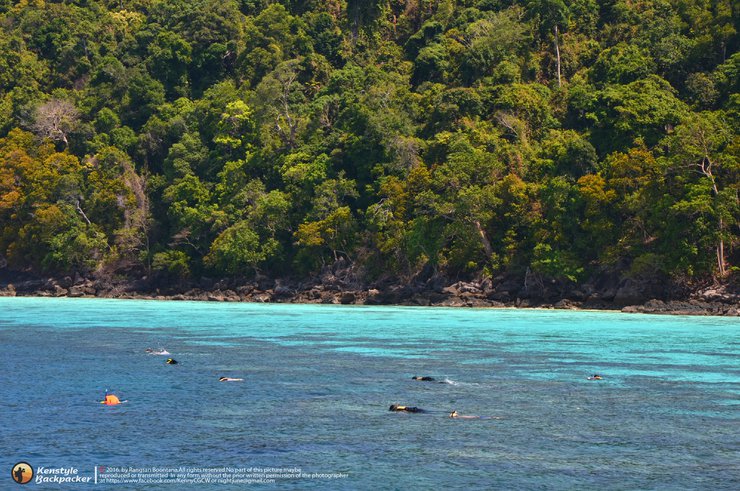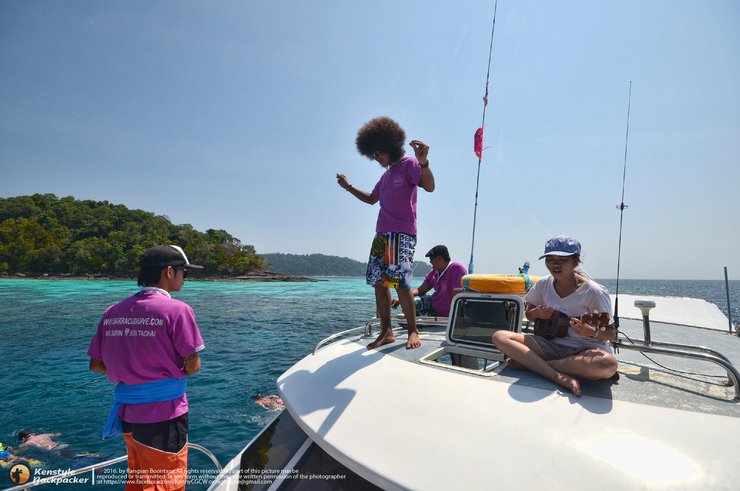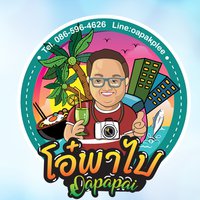...returning to the area around Khao Lak, where I had traveled over 20 years ago. I had already visited three islands in the Phang Nga province:
- Koh Khao https://th.readme.me/p/6716
- Koh Tachai https://th.readme.me/p/2930
- Koh Similan https://th.readme.me/p/7804
The next island on our itinerary is Surin Island. As before, I booked a one-day tour with Barracuda Diving through a tour counter near Khao Lak for 2,500 baht. This time, the tour company's van picked me up from Khao Lak and took me to the Namkhem Marina Pier & Restaurant located in the Namkhem village. We set sail on a catamaran carrying nearly 20 foreign tourists. I was the only Thai tourist on board. The journey to Surin Island, approximately 60 km away, took 1.5 hours.



After more than an hour of sailing, the Ao Chong Khad Bay of the Surin Islands, which separates North and South Surin, began to come into view. The sea's color gradually shifted from deep blue to turquoise as it approached the shore, running parallel to the pristine white sand beach. The boat anchored offshore, allowing tourists to dive and snorkel among the vibrant coral reefs. I opted to capture the scenery with my camera, soaking in the atmosphere and reflecting on past memories in comparison to the present. In my opinion, the landscape has remained largely unchanged, retaining its stunning beauty and natural charm.




As I sailed towards the shore on a traditional Thai long-tailed boat, I couldn't help but notice the stark contrast between the world above and the world below the water's surface. Two decades ago, the beachfront was teeming with vibrant shallow-water coral reefs that stretched as far as the eye could see. Today, those reefs are almost entirely gone, replaced by vast stretches of sandy bottom, with only scattered patches of coral remaining in deeper waters. This dramatic change is likely due to a combination of factors, including human-induced climate change, which has led to coral bleaching, as well as destructive practices such as anchoring on coral reefs, harvesting coral for sale, and the devastating tsunami that struck several years ago.


The long-tailed boat brought us to the northern part of Surin Islands, where the park ranger unit is located. This unit serves as the central hub for tourism activities in the Surin Islands. Whether you need accommodation, food, or diving tours to various bays, you can arrange everything here.
Specifications: The Surin Islands consist of 5 islands: North Surin Island, South Surin Island, Koh Ri (Koh Stork), Koh Khai (Koh Torinla), and Koh Klang (Koh Pajumba). The Surin Islands cover an area of approximately 135 square kilometers. The Surin Islands are a prominent tourist destination known for their beautiful underwater scenery, including diverse coral reefs and a wide variety of marine life. Additionally, the Surin Islands boast abundant forest resources, primarily consisting of three types of large forests: evergreen forests found throughout the mountains, coastal forests, and mangrove forests. Decades ago, the Royal Forest Department officially declared the Surin Islands a national park on July 9, 1981. The Surin Islands are the 29th national park in Thailand. The Surin Islands provide shelter from the wind and waves during both seasons due to their clustered arrangement and large bays, resulting in fringing reefs surrounding North Surin Island, South Surin Island, and the surrounding islands. The oceanographic conditions of the Surin Islands are ideal for coral reef development due to the clear water, suitable temperature, and mixing of nutrient-rich water from the deep ocean currents that collide with the islands. The abundance of plankton on the Surin Islands contributes to the thriving coral reefs. North Surin Island and South Surin Island are situated close together, resembling twin islands, separated by shallow water approximately 200 meters wide. During low tide, it is possible to cross to the other island, known as Ao Chong Khad Bay. The three smaller islands are rocky islands with sparse vegetation of stunted trees. The flora found on the islands is characterized by moist tropical forests, serving as the origin of one of the largest and most intact shallow-water coral reefs in Thailand. Source: http://www.weloveandaman.com/





I wandered around the back of the island, taking pictures of the unique chicken-shaped and turtle-shaped rocks on the back beach. While I was engrossed in taking pictures, I came across a young Chinese tourist with a walking stick limping towards me. I went over to help her and we managed to communicate. She told me that she was backpacking with friends in Phuket and they were traveling by motorbike. Unfortunately, she had an accident and injured her leg. However, she had already booked a tour to visit the Surin Islands and didn't want to miss it, so she came despite her injury. Her friends continued on to Krabi, while she decided to explore on her own. She said that she would meet her friends in Bangkok on the way back. I invited her to walk and take pictures together. Afterwards, we went our separate ways. She went on a boat tour of the island and stayed on the island for another night. I continued on to visit the Moken village.




After lunch, as we were walking to board the boat, we saw foreign tourists looking up at the treetops and taking pictures. It was the flying squirrels, or b่าง, the island's native animals.


The next stop on the tour is a visit to the Moken people at Ao Bon. The Moken are an indigenous "sea people" group who have lived in this area for centuries. There are three main groups of sea people in Thailand: the Urak Lawoi, the Moklen, and the Moken. These three groups traditionally migrated between different islands in the Andaman Sea according to the seasons. However, they have increasingly settled permanently in recent times, particularly the first two groups, who are considered "new Thais" and speak Thai. The Moken people who live on Surin Island have also begun to adapt their way of life following the tsunami over a decade ago, which forced them to relocate and build temporary shelters in Ban Nam Khem. However, they were unable to bear being away from their home for too long, so the authorities later built new homes for them on Surin Island. It is likely that they will increasingly settle permanently in the future.



The Moken people are primarily fishermen who travel by boat to various islands to fish, collect shellfish, catch crabs, harvest sea cucumbers, and gather bird's nests. These goods are then exchanged with mainland shopkeepers for food and daily necessities. Since the opening of their villages to tourism, the Moken have also begun selling handcrafted souvenirs to visitors, such as shell bracelets and miniature gabaang boats (gabaang are traditional Moken dugout canoes made from rakam wood, but due to their short lifespan, they are now often made from wooden planks).







Despite the changes in the Moken people's way of life due to the Department of National Parks' conservation efforts, which have restricted their access to traditional food sources, their culture and traditions remain strong. As their way of life has gained global attention, the Moken have begun to welcome tourists, with younger generations taking on roles as tour guides, boat drivers, and park rangers. Despite these changes, ancient customs and beliefs, such as ancestor worship and respect for nature, are still practiced. During the tsunami, the Moken's knowledge of natural signs helped them warn tourists and seek refuge on higher ground, minimizing casualties. Their houses retain their traditional thatched roofs, while solar panels provide electricity. The gaba, a traditional boat, remains essential for transportation, fishing, and temporary housing during seasonal migrations.





The Moken people are a stateless and ethnically diverse minority group. Despite being born in Thailand, they were granted the surname "Klatalay" by the Queen Mother, resulting in all Moken people sharing the same surname. Due to limited access to education, both children and adults within the Moken community face challenges. Their status as a minority group in Thailand is further compounded by the lack of government support compared to other seafaring communities, such as the Urak Lawoi and Moken groups residing in Phang Nga with access to land for cultivation.




As the afternoon waned, the boat transported the tourists back to shore, allowing them to enjoy one final snorkeling session at Ao Bon Bay. Afterward, they embarked on their return journey to Ban Nam Khem Pier. Stay tuned for our next review, where we'll explore the wonders of Phang Nga Bay.



Travel
Regardless of your chosen mode of transportation, Khao Lak offers the most convenient accommodation options. With a wide range of lodging choices starting from a few hundred baht, you can easily find a place to stay. Tour packages can be purchased along the main road in Khao Lak, with one-day trip prices varying slightly. For a comprehensive exploration, consider booking a two-day, one-night or three-day, two-night trip. Accommodation options on the Surin Islands include both tents and bungalows.
-Thank you to all my friends who came to watch and like and share. It really means a lot to me.
- Exchange information or ask for travel information Fanpage: Studdoy Hundred Stories
- Follow our previous articles here: All travel trips
สตั๊ดดอย ร้อยเรื่องราว
Friday, October 4, 2024 3:13 PM




